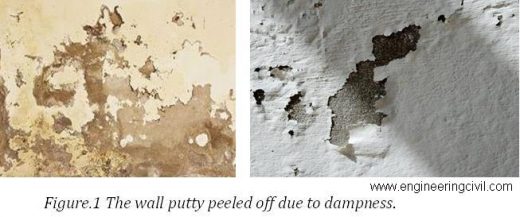By
Er. Vaishnav C R Nair
Introduction
The slabs are made depressed in depth form the general floor level in wet area like toilets, balconies, wash area in kitchen etc. This is to ensure the wet and dry area separations in buildings. Even though the sunken slabs provided the toilet and balcony areas are found with a major quality problem of Dampness. This is due to the continues contact of water with building blocks. Here comes the importance of Kerb Construction.
Effect of dampness?
Dampness causes the wall suitable for the fungal attack. Also it results in the peeling off of wall plaster and the putty applied. Thus creates a major quality as well as aesthetic issue.

Figure.1 The wall putty peeled off due to dampness.
What is Kerb?
Kerbs are small PCC Belt provided over sunken slabs before starting the block work as per set out drawing. The Kerb can be constructed with at least a height of 20 cm and a width corresponding to Block or Brick coming over it as per the Drawing. It should be constructed and cured well before starting the Block work.
Why Kerb?
It was seen from many of the construction site that the first course of block are made by Solid Blocks in order to avoid the Leakage. May be the Solid blocks can prevent leakage but the dampness cannot. The solid blocks used when comes in continues contact with water absorbs water from the wet area and this water spreads over the wall wherever it can go. This wetness of wall causes the Quality Issue Dampness.
What kerbs do?
Kerbs prevent the blocks from absorbing water from the contact area and make the water proofing effective.
Conclusion.
• It is better to construct the PCC Belt, which is the Kerb at all sunken area especially where the walls come in direct contact with water.
• The height of the Kerb should be at least 20 cm over the sunken slab and 15 cm over the general slab.
• The width of the Kerb should be the width of the wall / block which comes above it as per the drawing.
We at engineeringcivil.com are thankful to Er. Vaishnav C R Nair for submitting this information to us. We hope this would be of immense help to other civil engineering students.
If you have a query, you can ask a question here.



Site knowledge